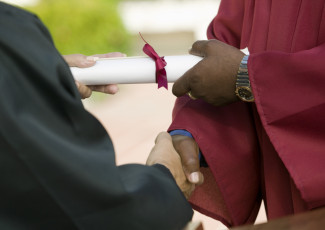Q&A: Transfer Agreement With Black Colleges
By Sonya Stinson
April 13, 2015
In California, community colleges stay true to their mission of helping all students achieve success.
When the majority of students in a community college system have their sights set on obtaining a bachelor’s degree, it makes sense to encourage them to explore every avenue to reach that goal — even if it means leaving the state.
Leaders at California community colleges saw a prime opportunity to help more students of color transfer to four-year institutions when last month the colleges entered into a unique partnership with nine historically black colleges and universities (HBCUs). In what is believed to be the first agreement of its kind, California community college students who complete an associate degree with at least a 2.5 GPA are guaranteed admission as juniors to an out-of-state HBCU.
In a recent interview with the 21st-Century Center, California Community College Chancellor Brice Harris talked about how this new initiative ties in with the system’s overall mission to help all students find the path to reach their full potential.
How did this historic transfer agreement come about?
It got started nearly two years ago. It began as a conversation with Vice Chancellor Linda Michalowski, who recently retired. There was an increasing desire on our part to make sure our students had a full range of options available to them.
Our colleges had been sending groups of students to HBCUs to do campus tours. It just seemed to be something that we ought to make more seamless for all of our students.
Why were you eager to get behind the idea, and what do you hope the partnership will achieve?
I really do have a strong feeling that both public and private institutions of all shapes and sizes ought to be available to California community college students. It’s not unlike the children in my own family: One of my sons was a tremendous fit with a small private institution, while one of my daughters was a big land-grant university kind of student. But both of them started at a community college.
When I look especially at our students of color, I want to make certain they know that they have options beyond the traditional ones here in California. For me, that’s why the HBCUs were so important. If you look at the reputation of the HBCUs — the statistics on the number of [federal] court appointees who have come through those institutions, the number of scientists, the number of attorneys and elected officials — you can’t help but be impressed with that.
How does this program complement the community college system’s other efforts to facilitate student transfers to institutions that grant bachelor’s degrees?
One of the primary things it does is expand the horizons for our students. In California and in community colleges across the country, students often feel place-bound. Many of them begin their education with a lack of confidence in terms of whether they can even go to college. So once they get into our institutions, a lot of them, if they believe they are going to transfer, will tend to stay close to home and transfer to the CSU [California State University] that’s just down the street or maybe to a private university here in California.
One of the things that this agreement with the HBCUs does is say to students, there are options even beyond the boundaries of the state of California that you might look at.
These numbers won’t be huge. I think we have 500 or 600 students currently enrolled in HBCUs, and maybe that number over the next few years will double.
Why have you made improving transfer rates such an important component of your mission?
More than half our students tell us that [preparing to transfer to a four-year college] is why they are here. When we find, as we have in the past few years here in California, that our big public institutions have had to limit the number of transfers, it’s important that we do everything we can to make [other] options available to our students.
Any final thoughts?
I just can’t be complimentary enough of the partnership and the leadership of the historically black colleges and universities that participated in this. It would have been easy for them to say, “California is halfway across the country. Those students aren’t going to be interested in coming here.” And yet, not only did they fully participate in this, but a large number of them got on an airplane and came out here to California for the ceremony. I don’t know how much louder a voice they could have spoken to our students in California to say, ‘We want you, and we welcome you to come to our colleges and universities.’”








